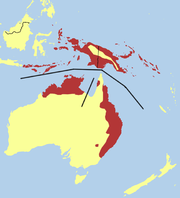Aviceda
Appearance
| Baza | |
|---|---|

| |
| Black baza (Aviceda leuphotes) | |
| Scientific classification | |
| Domain: | Eukaryota |
| Kingdom: | Animalia |
| Phylum: | Chordata |
| Class: | Aves |
| Order: | Accipitriformes |
| Family: | Accipitridae |
| Subfamily: | Perninae |
| Genus: | Aviceda Swainson, 1836 |
| Type species | |
| Aviceda cuculoides[1] Swainson, 1837
| |
The bazas,[2] Aviceda, are a genus of bird of prey in the family Accipitridae. The genus has a widespread distribution from Australia to southern Asia and across to Africa. The bazas are sometimes known as cuckoo-hawks. A prominent crest is a feature of the bazas. They have two tooth-like indentations on the edge of the upper bill.
Etymology
[edit]Aviceda: Latin: avis 'bird'; -cida 'killer', from caedere 'to kill'.[3]
Species
[edit]| Common name | Scientific name and subspecies | Range | Size and ecology | IUCN status and estimated population |
|---|---|---|---|---|
| African cuckoo-hawk | Aviceda cuculoides Swainson, 1837 Three subspecies
|
Sub-Saharan Africa and eastern parts of southern Africa | Size: Habitat: Diet: |
LC |
| Jerdon's baza | Aviceda jerdoni (Blyth, 1842) Six subspecies[5]
|
South-east Asia | Size: Habitat: Diet: |
LC |
| Black baza | Aviceda leuphotes (Dumont, 1820) Three subspecies
|
Northeast India, the eastern Himalayas, China and Southeast Asia.
|
Size: Habitat: Diet: |
LC |
| Madagascar cuckoo-hawk | Aviceda madagascariensis (Smith, 1834) |
Madagascar.
|
Size: Habitat: Diet: |
LC |
| Pacific baza | Aviceda subcristata (Gould, 1838) Thirteen subspecies
|
Australia, Indonesia, Papua New Guinea, and Solomon Islands and South Africa and East Timor
|
Size: Habitat: Diet: |
LC |
References
[edit]- ^ "Accipitridae". aviansystematics.org. The Trust for Avian Systematics. Retrieved 2023-07-26.
- ^ Etymological note: the common name "baza" is derived from baaz, the Hindi name for the northern goshawk, (Accipiter gentilis). Baaz has its origins in Arabic.
Aasheesh Pittie. "A dictionary of scientific bird names originating from the Indian region". Retrieved 24 September 2015. - ^ Jobling, J.A. (2017). "Key to Scientific Names in Ornithology". In del Hoyo, J.; Elliott, A.; Sargatal, J.; Christie, D.A.; de Juana, E. (eds.). Handbook of the Birds of the World Alive. Barcelona: Lynx Edicions.
- ^ BirdLife International. (2021). "Aviceda cuculoides". IUCN Red List of Threatened Species. 2021: e.T22694944A202201600. doi:10.2305/IUCN.UK.2021-3.RLTS.T22694944A202201600.en.
- ^ Peters, James Lee (1931). Check-list of birds of the world. Volume 1. Cambridge: Harvard University Press. pp. 195–196.
- ^ BirdLife International. (2020). "Aviceda jerdoni". IUCN Red List of Threatened Species. 2020: e.T22694956A181759887. doi:10.2305/IUCN.UK.2020-3.RLTS.T22694956A181759887.en.
- ^ BirdLife International. (2021). "Aviceda leuphotes". IUCN Red List of Threatened Species. 2021: e.T22694964A202412049. doi:10.2305/IUCN.UK.2021-3.RLTS.T22694964A202412049.en.
- ^ BirdLife International. (2016). "Aviceda madagascariensis". IUCN Red List of Threatened Species. 2016: e.T22694950A93480785. doi:10.2305/IUCN.UK.2016-3.RLTS.T22694950A93480785.en.
- ^ BirdLife International. (2016). "Aviceda subcristata". IUCN Red List of Threatened Species. 2016: e.T22694961A95221429. doi:10.2305/IUCN.UK.2016-3.RLTS.T22694961A95221429.en.






